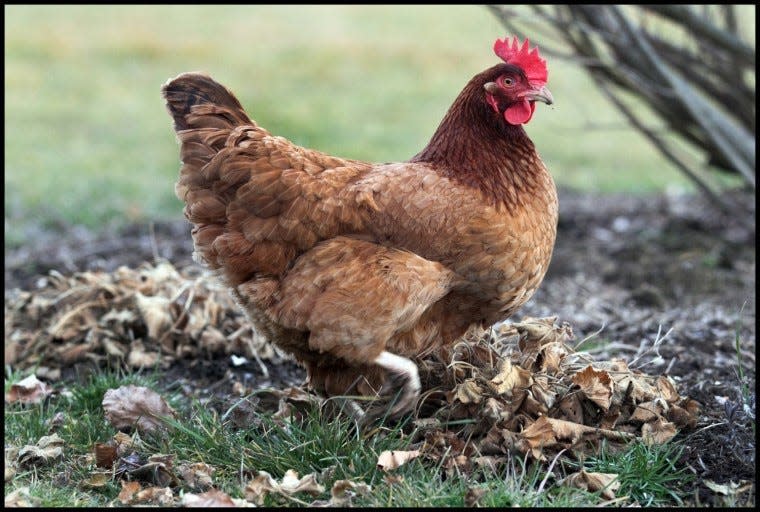Why did RI choose a chicken as the state bird? The history of the Rhode Island Red
The vast majority of states chose pretty little songbirds as their state bird.
Massachusetts went with the black-capped chickadee. Connecticut went for the ubiquitous American robin. The Northern cardinal is the state bird in no fewer than six states.
But in Rhode Island, we went in a different direction with our state bird, favoring something more practical and truly from the state: the Rhode Island Red, a hardy bird that lays extra-large brown eggs. A bird you can count on.
It does, however, spark some questions. One What and Why RI reader wrote in asking, “Where did the Rhode Island Reds come from? I heard Little Compton.” There's also the question of why it's the state bird at all.
What and Why RI: It's filled in now, but in its prime Rocky Point pool hosted Olympians. Here's the story.

What’s the history of the Rhode Island Red?
Our question-asker heard right, but we can be more specific. The Rhode Island Red was bred in the Little Compton village of Adamsville, according to historical documents compiled by Don Nelson, of the Little Rhody Poultry Fanciers.
At the corner of William Sisson Road and Long Highway, there’s a small plaque on the stone wall that marks the spot as the birthplace of the Rhode Island Red.
This was the farm of William Tripp, who in 1854 began experimenting with the breeding of Asiatic fowl. With contributions from John Macomber from Westport, Massachusetts, he crossed Cochin China hens with Malay and Java cocks, according to the Rhode Island Heritage Hall of Fame. The pair of them found that these birds laid better eggs and produced better meat, so they kept breeding them. They would exchange their best birds, until Macomber died, to prevent too much inbreeding. They were widely called “Tripp fowls.”
This attracted the notice of fellow Little Compton resident Isaac C. Wilbour.
In the 1880s Wilbour was running a 200-acre farm with 3,000 to 4,000 chickens, Wilbour’s grandson David Patten wrote in a 1954 pamphlet.
What and Why RI: Rhode Island has a lot of villages, and they can be confusing. We try to answer why
“I remember many men coming from trade magazines to write it up,” Patten wrote. “Little Compton had become the biggest poultry town in the United States. It was the first place in the whole country where the people depended on hens and geese for their livelihoods.”
Patten wrote that Tripp fowls attracted the attention of his grandfather “when he went into the poultry business in a big way,” so sometime before the 1880s.
Wilbour bought some of the Tripp fowls and began his own crossbreeding with some birds that were more common to the area.
“What he was after was a better all-purpose bird,” writes Patten. “An improved utility fowl that would lay more eggs, bigger and browner eggs for the Boston and Providence markets, and larger bodies to provide more meat. He seemed to have no desire to breed show birds, but wanted the hardiest kind of stock that would prosper under any conditions, including those of a rigorous New England winter.”
These birds attracted the attention of two University of Rhode Island professors, who in the earlier 1890s pressed Wilbour to give his breed of chickens a name.
“Grandfather must have given thought to this problem. He said, 'Why wouldn't Rhode Island Reds do?'” Patten wrote.
In 1896, Wilbour began to advertise the new breed in poultry magazines, and in 1904 standards were adopted by the American Standard of Perfection, the official breed standard for the poultry fancy in North America.
What and Why RI: We've all seen the construction near Providence on I-95. How long until it's finished?
Why is the Rhode Island Red the state bird?
In 1954, to celebrate the 100th anniversary of the start of the Rhode Island Red, the Rhode Island Red Centennial Committee formed, and one of their ideas — in addition to a big chicken barbeque — was recommending the Rhode Island Red as the state bird.
It was hotly debated in the legislature, according to Providence Journal reports.
The fowl faced stiff competition from ospreys and hummingbirds, and there were complaints that a poll that had gone out to residents was unfair. Legislators who were opposed made some rather pointed remarks about the barnyard bird.
“Brother, we’re laying an egg here. It can neither sing nor fly,” Sen. William L. McCaughey of Pawtucket said.
“Can you imagine when the tourists come during molting season and see a flock of Rhode Island Reds?” Sen. Lois B. Plummer of Middletown said during the debates. “'That’s your state bird,’ they’ll say. ‘Why don’t you dress him up?’”
What and Why RI: The Awful Awful is a classic Rhode Island treat. Here's how it got its name.
Other legislators reportedly leaped to the bird’s defense, saying that it was pretty “whether a day old chick or a full grown show bird,” can sing (well, cluck at least), and can fly.
In the end, the Rhode Island Red won the day with a clear majority. There are no reports of tourists being offended by the bird, which is often used as a business logo.
What and Why RI is a weekly feature by The Providence Journal to explore our readers' curiosity. If you have a question about Rhode Island, big or small, email it to klandeck@gannett.com. She loves a good question.
This article originally appeared on The Providence Journal: RI's state bird is the Rhode Island Red. How a chicken got the title.

